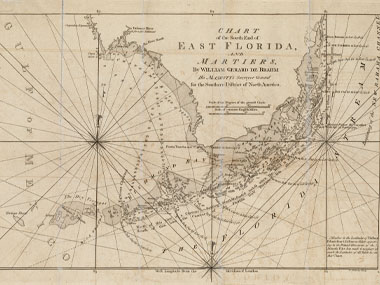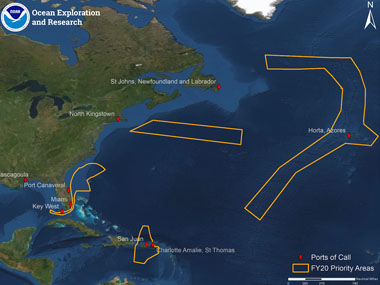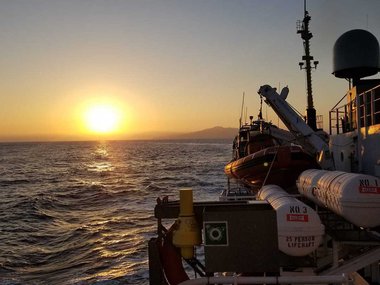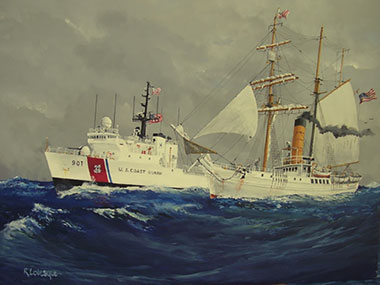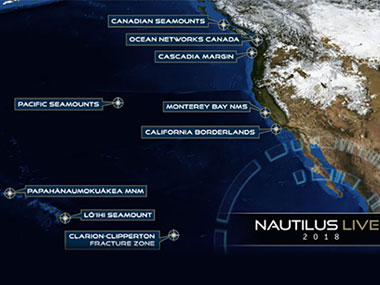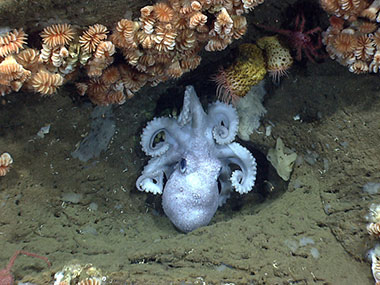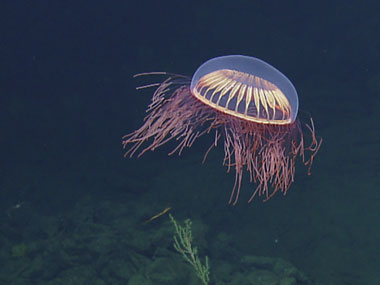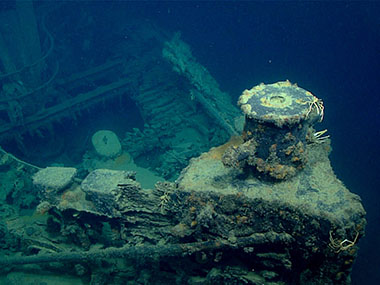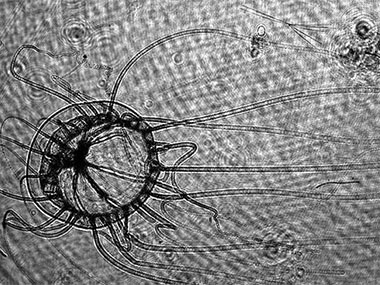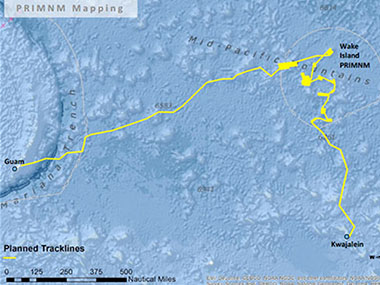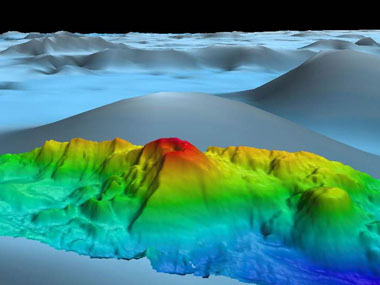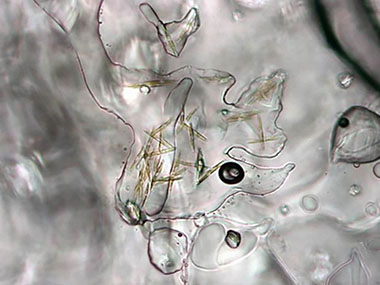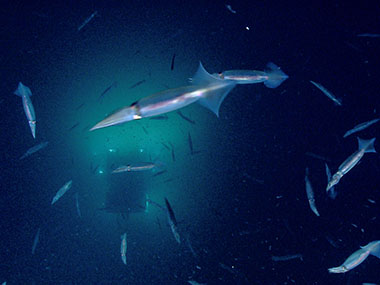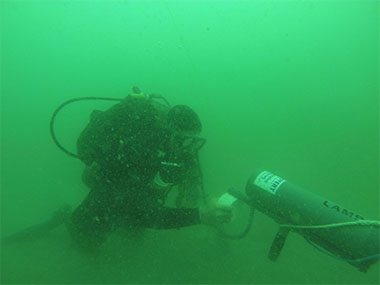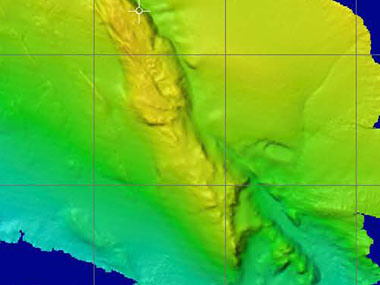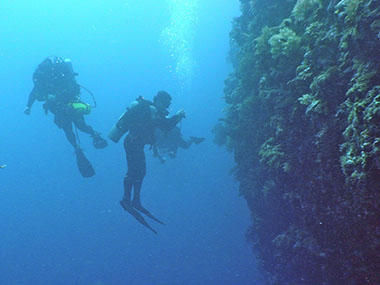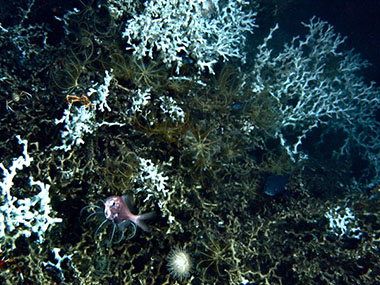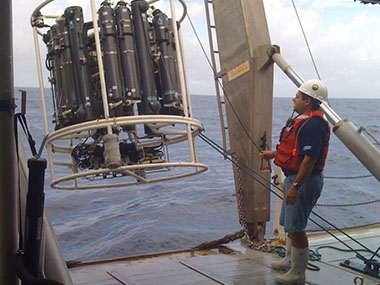NOAA Ocean Exploration supports research expeditions to explore previously unvisited areas of the ocean. We provide partnership coordination, funding, staff, tools, and expertise needed to develop mission plans that deliver rigorous, systematic observations and documentation of biological, chemical, physical, geological, and archaeological aspects of the ocean. Follow NOAA Ocean Exploration-supported expeditions, including those on NOAA Ship Okeanos Explorer, while they are underway or trace the activities and discoveries of past expeditions by clicking on the expedition-specific links below. For each expedition, you'll find information ranging from expedition plans and feature stories to educational materials and expedition daily updates, videos, and images.
In addition to browsing expeditions by topic below, you can also browse expeditions by location or by year.
From coral ecosystems to marine archaeology and seafloor mapping, find ocean explorations that pique your interest by selecting from the topics below.
2021

2021 U.S. Blake Plateau Mapping
August 15 - September 28, 2021: NOAA Ocean Exploration will conduct two telepresence-enabled exploratory ocean mapping expeditions on NOAA Ship Okeanos Explorer. These expeditions will include 24-hour-a-day acoustic exploration mapping operations in areas generally deeper than 200 meters (656 feet) in U.S. waters off the east coast, with a focus on the Blake Plateau.
2021

The Search for Norlindo – The First World War II Casualty in the Gulf of Mexico
August 18 - September 5, 2021: A team comprised of German, Italian, and American scientists and archaeologists will embark on a three-week expedition to search for SS Norlindo, an American steam freighter sunk on May 4, 1942, off of the Dry Tortugas by the German U-boat U-507. The sinking of Norlindo marked the first World War II combat casualties in the Gulf of Mexico.
2021

Maritime Heritage in America’s Inland Seas
July 28 - August 20, 2021: From July 28 to August 20, 2021, an interdisciplinary team of researchers led by NOAA’s Office of National Marine Sanctuaries will be conducting autonomous survey and exploration of the Wisconsin Shipwreck Coast National Marine Sanctuary and the proposed Lake Ontario National Marine Sanctuary July 28-August 20.
2021

E/V Nautilus: 2021 Field Season
July - December 2021: The Ocean Exploration Trust will use Exploration Vessel (E/V) Nautilus to explore the waters along the North American West Coast from British Columbia to Southern California and west to the Hawaiian Islands and Papahānaumokuākea Marine National Monument.
2021

Florida Keys National Marine Sanctuary Quicksands Archaeological Surveys
June 14 - 27, 2021: Archaeologists and ecologists from the NOAA Office of National Marine Sanctuaries (ONMS) and the University of Miami’s Rosenstiel School of Marine and Atmospheric Science (RSMAS), with funding support from NOAA Ocean Exploration, conducted an exploratory marine archaeological remote sensing and diving survey to locate and characterize archaeological sites within an area of Florida Keys National Marine Sanctuary (FKNMS) known as the “Quicksands,” located west of Key West, Florida.
2021

2021 ROV Shakedown
June 13 - June 27, 2021: NOAA Ocean Exploration will conduct a shakedown of its dual-body remotely operated vehicles (ROVs) Deep Discoverer and Seirios on NOAA Ship Okeanos Explorer in the Atlantic Ocean between Norfolk, Virginia, and Newport, Rhode Island. The expedition will include engineering test dives in water depths up to approximately 5,000 meters (3.1 miles). ROV dives will be conducted during the day with overnight mapping operations.
2021

Search for U.S. Revenue Cutter Bear: Have We Found It?
June 10 - June 20, 2021: For nearly two decades, NOAA Ocean Exploration, the NOAA Office of National Marine Sanctuaries’ Maritime Heritage Program, the U.S. Coast Guard, and a number of academic research partners have been engaged in a search for the final resting place of U.S. Revenue Cutter Bear.
2021

2021 Technology Demonstration
May 14 - May 27, 2021: From May 14-27, 2021, NOAA Ocean Exploration will lead the 2021 Technology Demonstration on NOAA Ship Okeanos Explorer from Cape Canaveral, Florida, to Norfolk, Virginia. The expedition provides an opportunity to test several technologies that will allow the ocean exploration community to explore deeper, farther, and more comprehensively than previously possible.
2021

2021 EM 304 Sea Acceptance Testing and Mapping Shakedown
April 16 - May 10, 2021: The NOAA Office of Ocean Exploration and Research will begin the 2021 operations aboard NOAA Ship Okeanos Explorer with a 25-day expedition to assess the functionality and ensure readiness of mapping-related equipment, including a new state-of-the-art EM 304 multibeam sonar transducer.
2020

Gradients of Blue Economic Seep Resources
September 2020: In this expedition on Exploration Vessel Nautilus, we aim to explore how methane seeps interact with ocean systems and seek out expanding avenues in an ocean blue economy future.
2020

E/V Nautilus: 2020 Field Season
September to December 2020: The Ocean Exploration Trust, in partnership with the Office of Ocean Exploration and Research, the NOAA Ocean Exploration Cooperative Institute, the NOAA Office of National Marine Sanctuaries, and Ocean Networks Canada, will use Exploration Vessel (E/V) Nautilus to explore little-known regions along the North American West Coast from British Columbia to Southern California.
2020

Bioprospecting for Industrial Enzymes and Drug Compounds in an Ancient Submarine Forest
August-December 2020: Nearly 60,000 years ago, a bald cypress forest flourished on the banks of a prehistoric river near the Gulf of Mexico. Now, a team of scientists from Northeastern University and the University of Utah, funded by the NOAA Office of Ocean Exploration and Research (OER), are working to unlock the forest’s secrets, including its potential to harbor new compounds for medicine and biotechnology.
2020

NOAA Ship Okeanos Explorer: 2020 Expeditions Overview
October 2019 - September 2020: The NOAA Office of Ocean Exploration and Research will embark on NOAA Ship Okeanos Explorer to conduct three regional expeditions starting with the U.S. Southeastern Continental Margin, moving to the Northern Caribbean, and finally, the Mid-Atlantic Ridge near the Azores.
2019

Surveying Deep-sea Corals, Sponges, and Fish Habitat
October-November 2019: NOAA, the Global Foundation for Ocean Exploration, the U.S. Geological Survey, and Bureau of Ocean Energy Management conducted a 29-day expedition to explore along the California, Oregon, and Washington coasts.
2020

Innovative Technology and Partnership Leads to New EEZ Mapping
Fall 2019: In the fall of 2019, capitalizing on existing hydrographic survey contract mechanisms through NOAA’s Office of Coast Survey, the NOAA Office of Ocean Exploration and Research (OER) and the National Oceanographic Partnership Program funded the geodata specialist company Fugro to conduct a survey in the Blake Plateau region off the coasts of Georgia and Florida.
2020

Exploring Deepwater Ecosystems with eDNA
September 2019: A team of ocean scientists and engineers from Lehigh University and Woods Hole Oceanographic Institution used NOAA Research Vessel R/V MANTA and the newly developed autonomous underwater vehicle Mesobot to collect environmental DNA in order to explore the biodiversity of deepwater ecosystems near Flower Garden Banks National Marine Sanctuary in the Northwestern Gulf of Mexico.
2019

Deep Connections 2019
August-September 2019: NOAA and partners conducted an expedition on NOAA Ship Okeanos Explorer to explore deepwater areas of the U.S. and Canadian Atlantic continental margin.
2019

Finding Boundaries in the Deep Sea
July-August 2019: Scientists will study the benthic (seafloor) communities of seamounts in the North Pacific to determine if/how water masses influence the difference in deepwater fauna between the Aleutians and Hawaii.
2019

Gulf of Alaska Seamounts 2019
July-August 2019: A multi-disciplinary and international team sailed to the Gulf of Alaska Seamounts region to collect data to help us better understand the diversity of marine life in this underexplored region.
2019

2019 Technology Demonstration
July-August 2019: NOAA and partners conducted a mission on NOAA Ship Okeanos Explorer to demonstrate, test, and evaluate five emerging and existing technologies for possible integration into NOAA operations.
2019

Windows to the Deep 2019
May - July 2019: NOAA and partners conducted an expedition on NOAA Ship Okeanos Explorer to explore unknown and poorly understood deepwater areas of the southeastern United States.
2019

E/V Nautilus: 2019 Field Season
May - October 2019: Scientists will use the Ocean Exploration Trust’s Exploration Vessel (E/V) Nautilus to document and survey unexplored regions along the West Coast of the United States and in the Central Pacific, including American Samoa and U.S. Territorial Islands.
2018

Mapping Deepwater Areas in the Caribbean and South Atlantic Bight
November - December 2018: NOAA Office of Ocean Exploration and Research and partners conducted telepresence-enabled mapping and remotely operated vehicle dives in the deep waters of the U.S. Exclusive Economic Zone, Bahamas, Dominican Republic, and Turks and Caicos Islands.
2018

Kiska: Alaska's Underwater Battlefield
July 2018: This team built on existing archaeological and historical data to explore the underwater battlefield of Kiska Island, Alaska, which is one of the least studied, yet most significant sites of World War II.
2018

ASPIRE
2018 - 2020: The Atlantic Seafloor Partnership for Integrated Research and Exploration, or ASPIRE, is a collaborative ocean exploration field program focused on the North Atlantic Ocean.
2018

Windows to the Deep 2018
May - July 2018: NOAA and partners conducted an expedition on NOAA Ship Okeanos Explorer to collect critical baseline information about unknown and poorly understood deepwater areas of the Southeastern United States.
2018

Aviators Down
June - September 2018: Between June 27 and September 26, 2018, a team surveyed five areas of Lake Huron within and adjacent to Thunder Bay National Marine Sanctuar, searching for lost World War II training aircraft.
2018

E/V Nautilus: 2018 Field Season
June - November 2018: Scientists used the Ocean Exploration Trust’s Exploration Vessel (E/V) Nautilus to document and survey unexplored regions from British Columbia, Canada, along the West Coast of the United States, and the Hawaiian Islands.
2018

DeepCCZ
May - June 2018: The DeepCCZ Project used the best-available technology in deep-sea ecological, taxonomic, and connectivity studies to study deep-sea biodiversity in the western Clarion-Clipperton Zone (CCZ) of the central Pacific Ocean.
2018

Voyage to the White Shark Café
April - May 2018: A multidisciplinary team aboard the Research Vessel Falkor journeyed to an open patch in the Pacific Ocean known as the “White Shark Café” to study one of the most iconic predators in the ocean: The white shark.
2018

Gulf of Mexico 2018
April - May 2018: NOAA and partners conducted a telepresence-enabled ocean exploration expedition on NOAA Ship Okeanos Explorer to collect critical baseline information about unknown and poorly understood deepwater areas in the Gulf of Mexico.
2018

Peleliu’s Forgotten World War II Battlefield
March - April 2018: This project was the first of its kind in Peleliu to explore the landing beaches and fringing reef by conducting a comprehensive, systematic remote sensing search for the material remains from this forgotten battlefield.
2018

Gulf of Mexico Technology Demonstration
March - April 2018: The Gulf of Mexico Technology Demonstration was the first operational cruise on board NOAA Ship Okeanos Explorer in 2018, during which we conducted our first emerging technology demonstration projects.
2018

NOAA Ship Okeanos Explorer: 2018 Overview
October 2017 - September 2018: NOAA Ship Okeanos Explorer returned to the Atlantic Ocean and conducted a series of expeditions to continue exploration of the deep waters of the U.S. Gulf of Mexico and North Atlantic.
2017

Gulf of Mexico 2017
November - December 2017: A team of scientists and technicians, both at-sea and shore-based, conducted exploratory investigations into the diversity and distribution of deep-sea habitats and associated marine communities in the Gulf of Mexico basin.
2017

Discovering Deep-Sea Corals of the Phoenix Islands
October - November 2017: The goal of this expedition was to provide the first glimpse of the deepwater communities within the largest and deepest UNESCO World Heritage Site on Earth, the Phoenix Islands Protected Area.
2017

Musicians Seamounts Telepresence Mapping
August 2017: Operations during the expedition included focused mapping and strategic mapping transits by NOAA Ship Okeanos Explorer within the waters of Hawaii and in international waters at the Musician Seamounts chain.
2017

Cuba’s Twilight Zone Reefs and Their Regional Connectivity
May - June 2017: The R/V F.G. Walton Smith circumnavigated Cuba, conducting daily remotely operated vehicle dives to focus on the mesophotic reef in order to discover and characterize the extent of mesophotic reefs in Cuba and to compare the health and connectivity (physical, genetic, and ecological) among the mesophotic and shallow coral reef systems in Cuba and the United States.
2017

Exploring Methane Seeps on the U.S. Mid-Atlantic Margin: IMMeRSS
May 2017: Scientists on the IMMeRSS (Interagency Mission for Methane Research at Seafloor Seeps) expedition focused on the geology, ecology, chemistry, and physics of methane seeps on the U.S. Mid-Atlantic margin between Baltimore Canyon and Hatteras Canyon at water depths of 400-1,600 meters.
2017

Exploring the Sunken Heritage of Midway Atoll
May 2017: Scientists explored sunken aircraft associated with the Battle of Midway, adding an important maritime heritage component to our understanding of the broader history of World War II in the Pacific.
2017

E/V Nautilus: 2017 Field Season
May - November 2017: The Ocean Exploration Trust conducted the third year of exploration in the Eastern Pacific Ocean on Exploration Vessel Nautilus, as scientists documented and surveyed unexplored regions from British Columbia, Canada, along the West Coast of the United States, and to Baja California, Mexico.
2017

Mountains in the Deep: Exploring the Central Pacific Basin
April - May 2017: NOAA and partners conducted a telepresence-enabled expedition on NOAA Ship Okeanos Explorer to collect critical baseline information about deepwater areas as it transited across the northern portion of the Cook Islands, with focused work in the vicinity of both the Jarvis Island and Kingman/Palmyra units of the Pacific Remote Islands Marine National Monument, prior to returning to Honolulu.
2017

Discovering the Deep: Exploring Remote Pacific Marine Protected Areas
March 2017: NOAA and partners conducted a telepresence-enabled ocean exploration expedition on NOAA Ship Okeanos Explorer to collect critical baseline information about unknown and poorly known deepwater areas in the Howland and Baker Unit of the Pacific Remote Islands Marine National Monument and the Phoenix Islands Protected Area.
2017

NOAA Ship Okeanos Explorer: 2017 Overview
December 2016 - September 2017: A team of NOAA and external partners conducted the third year of the ‘Campaign to Address Pacific monument Science, Technology, and Ocean NEeds (CAPSTONE)’ field effort, deploying NOAA Ship Okeanos Explorer to investigate and document the diversity and distribution of deepwater environments in U.S. central Pacific waters, the high seas, and waters of several Pacific Island countries and territoies.
2016

Searching for Life in the Mariana Back-arc
November - December 2016: A team led by scientists aboard the Schmidt Ocean Institute’s Research Vessel Falkor traveled to the Mariana Back-arc, to explore newly discovered hydrothermal vents and the life they support.
2016

Exploring Carolina Canyons
August - September 2016: A team of scientists and engineers aboard NOAA Ship Pisces explored three deepwater canyons off the coast of North Carolina.
2016

E/V Nautilus: 2016 Field Season
May - September 2016: E/V Nautilus explored sites sites from British Columbia and along the west coast of North America down to southern California.
2016

2016 Deepwater Exploration of the Marianas
April - July 2016: NOAA and partners conducted a three-cruise expedition on NOAA Ship Okeanos Explorer to collect critical baseline information of unknown and poorly known areas in and around the Marianas Trench Marine National Monument and the Commonwealth of the Northern Mariana Islands.
2015

Hohonu Moana: Exploring the Deep Waters Off Hawai’i
July - September 2015: A team of NOAA and external partners both at-sea and on shore conducted mapping and remotely operated vehicle operations in the deep waters of the Hawaiian Archipelago, including the Papahānaumokuākea Marine National Monument and Johnston Atoll.
2015

Search for the Lost Whaling Fleets of the Western Arctic
August 2015: This expedition brought the NOAA Office of National Marine Sanctuaries’ Maritime Heritage Program to the remote and challenging Alaska region for the first time in the more than four decades since the creation of the National Marine Sanctuary Program.
2015

Bioluminescence and Vision on the Deep Seafloor 2015
July 2015: Scientists used combined expertise in bioluminescence, taxonomy, visual ecology, imaging and molecular biology, and the unique collecting capabilities and camera systems of the Global Explorer to continue studies of the deep-sea benthic environment in the Gulf of Mexico.
2015

Tropical Exploration 2015
May - June 2015: NOAA Ship Okeanos Explorer journeyed from the Atlantic Ocean to the Pacific Ocean, exploring along the way. Okeanos Explorer will leave Puerto Rico to traverse the Western Caribbean, Panama Canal, and Eastern Pacific.
2015

Mapping the Uncharted Diversity of Arctic Marine Microbes
January 2015 - August 2016: Scientists used next-generation DNA sequencing technologies and cutting-edge bioinformatics approaches to enable the discovery and characterization of the largely unknown molecular diversity of microbes associated with Arctic sea ice and seafloor habitats.
2015

E/V Nautilus: 2015 Field Season
April - September 2015: E/V Nautilus explored sites from the Gulf of Mexico to British Columbia. The season marked the transition of the vessel and operations to the west coast of the United States and the Pacific Ocean, concluding over two years of research in the Gulf and Caribbean regions.
2014

Submarine Ring of Fire 2014 - Ironman
November - December 2014: Scientists traveled to the Submarine Ring of Fire to study iron-oxidizing bacteria at hydrothermal vents and how carbon dioxide from submarine volcanoes impacts nearby biological communities.
2014

Seamounts of Anegada Passage 2014
September 2014: Scientists on board the Exploration Vessel Nautilus visited several unexplored seamounts that punctuate the seafloor within the Caribbean Sea, uncovering information about geologic, biologic, and oceanographic processes.
2014

E/V Nautilus: 2014 Field Season
June - October 2014: Exploration Vessel Nautilus embarked on a journey to document and research the regions of the Gulf of Mexico and Caribbean.
2014

NOAA - Boeing Echo Ranger Pilot AUV Mission 2014
May 2014: NOAA’s National Marine Fisheries Service Southwest Fisheries Science Center worked with Boeing under a Cooperative Research and Development Agreement to explore the potential applicability of the large autonomous underwater vehicle (AUV) Echo Ranger for a rockfish survey.
2014

East Coast Mapping
May 2014: NOAA Ship Okeanos Explorer conducted a 16-day mapping expedition beginning in Tampa, Florida, and ending at the ship’s homeport of North Kingstown, Rhode Island.
2014

HADES: Kermadec Trench Expedition 2014
April - May 2014: Scientists on board the R/V Thompson, used the hybrid remotely operated vehicle, Nereus, to explore systematically for the first time the hadal Kermadec trench system and the neighboring abyssal plain in the Southwestern Pacific.
2014

Exploration of the Gulf of Mexico 2014
February - May 2014: A team of scientists and technicians both at sea and on shore conducted exploratory investigations on the diversity and distribution of deep-sea habitats and marine life in the Gulf of Mexico.
2013

Coral Ecosystem Connectivity 2013: From Pulley Ridge to the Florida Keys
August 2013: The R/V F.G. Walton Smith and the M/V Spree combined efforts in the second year of a five-year study to investigate the role that the mesophotic reefs of Pulley Ridge may play in replenishing key fish species and other organisms in the downstream reefs of the Florida Keys and Dry Tortugas.
2013

Northeast U.S. Canyons Expedition 2013
July - August 2013: A team of scientists and technicians both at-sea and on shore conducted exploratory investigations on the diversity and distribution of deep-sea habitats and marine life along the Northeast U.S. Canyons and at Mytilus Seamount.
2013

New England Seamount Chain Exploration
June 2013: NOAA Ship Okeanos Explorer conducted seafloor and water column mapping operations in the Western North Atlantic Ocean over a portion of the New England Seamount Chain.
2013

Deepwater Canyons 2013: Pathways to the Abyss
April - May 2013: Scientists on the NOAA Ship Ronald H. Brown studied the biology of Norfolk Canyon, with some sampling in Baltimore Canyon and exploration of archaeological targets in and around the Norfolk Canyon area.
2012

Russian-U.S. Arctic Census 2012
August - September 2012: Learn how scientists conducted long-term research to better understand the causes and consequences of environmental change in the fragile Arctic environment.
2012

Deepwater Canyons 2012: Pathways to the Abyss
August - October 2012: Scientists aboard the NOAA Ship Nancy Foster explored and characterized hard- and soft-bottom communities as well as shipwreck sites in canyons off the coasts of Virginia and Maryland.
2012

Turkey and Cyprus Expedition 2012
July - August 2012: Learn what scientists uncovered while on board Exploration Vessel Nautilus to explore the Black Sea, Aegean Sea, and Mediterranean Sea off the coasts of Turkey and Cyprus.
2012

Exploring the Submerged New World 2012
July 2012: Scientists returned to two dive sites they visited in 2009, hoping to excavate late Pleistocene terrestrial sediments containing plants, animals, and perhaps artifacts from some of the first human beings to arrive in the New World.
2012

INSPIRE: Chile Margin 2012
April 2012: During a 10-day cruise on the Research Vessel Melville, scientists probed for strange new biological life forms, communities, and ecosystems dependent unknown conditions.
2012

Gulf of Mexico 2012
March - April 2012: A team of scientists and technicians both at-sea and on shore conducted exploratory investigations on the diversity and distribution of deep-sea habitats and marine life in the northern Gulf of Mexico.
2011

Atlantic Shelf Break Expedition 2011
September 2011: This mapping cruise commenced on September 15th, departing Pascagoula, Mississippi for a strategically planned offshore route to Rhode Island.
2011

Gulf of Mexico 2011
August – September 2011: Learn why the primary purpose of this expedition was to study the feasibility of using this capability to map gasses in the water column.
2011

Exploring the Submerged New World 2011
August 2011: Scientists returned to four dive sites they visited in 2009 to study the biology, geology, and oceanography of a series of canyons off the middle Atlantic coast of the U.S.
2011

Mid-Cayman Rise Expedition 2011
August 2011: NOAA Ship Okeanos Explorer traveled to the deepest part of the Caribbean Sea, where a team of international scientists both at-sea and on shore conducted interdisciplinary investigations of the Mid-Cayman Rise.
2011

New Frontiers in Ocean Exploration 2011
July - November 2011: Scientists from a multi-institute initiative conducted ocean exploration projects in the Black, Aegean, and Mediterranean Seas and the eastern Atlantic Ocean over a five-month period.
2011

Galápagos Rift Expedition 2011
July 2011: NOAA Ship Okeanos Explorer embarked on a unique expedition to one of the most fascinating areas of the world’s oceans to explore the water column and unexplored benthic environments in the Galápagos region.
2011

Pacific Deep Reefs 2011
February - March 2011: In this deep-diving expedition to the Southern Pacific, scientists characterized deep-reef communities and began the task of assessing organisms for their biotechnology potential.
2010

Aquarius 2010: If Reefs Could Talk
October 2010: NOAA’s Office of National Marine Sanctuaries hosted this research and education mission, bringing the science of ocean conservation and the underwater world to the public during live Internet broadcasts from the Aquarius undersea laboratory in the Florida Keys.
2010

Extended Continental Shelf Project 2010
August - September 2010: The 2010 Extended Continental Shelf survey was a five-week-long Arctic mapping expedition involving two icebreakers: U.S. Coast Guard Cutter Healy and the Canadian Coast Guard Ship Louis S. St-Laurent.
2010

Stellwagen Bank National Marine Sanctuary 2010
August - September 2010: Using high-resolution systematic surveys of a large area along the shipping routes used by Massachusetts’ oldest ports, scientists tried to locate historic shipwrecks, including a shipwreck from the earliest periods of United States history.
2010

Florida Shelf Edge Exploration 2010
July - August 2010: A science team on the research vessel Seward Johnson headed to the eastern Gulf of Mexico to assess and record conditions in the water column and on the seafloor to gather baseline data along Florida’s shelf edge as part of NOAA’s response to the Deepwater Horizon oil spill.
2010

Sea of Cortez Expedition 2010
April - May 2010: This unique expedition took place in Ballena Bay, just off the Isla Espíritu Santo. Learn why scientists hoped their findings would give them a better understanding of human migration into the New World.
2010

INSPIRE: Chile Margin 2010
February 2010: A diverse team of scientists tackled questions about strange new biological life forms, communities, and ecosystems far from the sunlit ocean surface at the Chilean Triple Junction.








